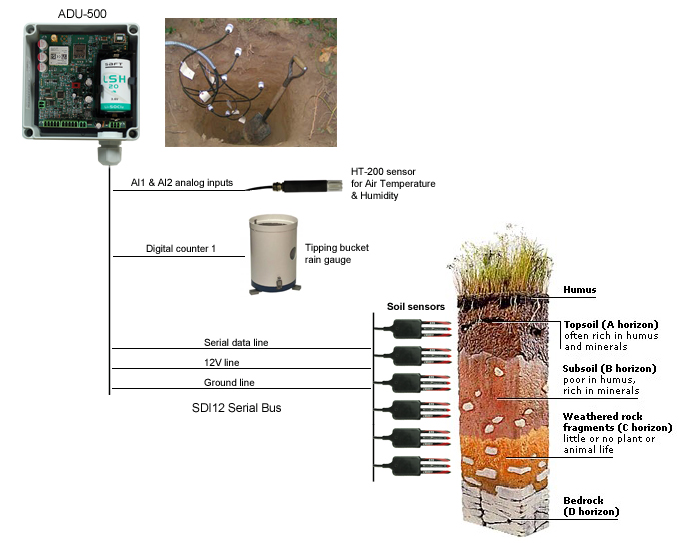Soil moisture measurements are important for a number of applications and for a number of different reasons. Applications include land slide studies, erosion, water shed studies, climate studies, predicting weather, flood warning, crop quality and yield optimization, irrigation, and soil remediation to name a few.
Measuring soil moisture is important in agriculture to help farmers manage their irrigation systems more efficiently. Not only are farmers able to generally use less water to grow a crop, they are able to increase yields and the quality of the crop by better management of soil moisture during critical plant growth stages.
In situ soil electrical conductivity monitoring is very important in agriculture because the salinity levels in soil moisture can have dramatic effects on crop health and yields. Agricultural soils over time may become sodic or saline and this may dramatically affect the health and yields of the crops. There are techniques that can remove the sodium to improve soil quality and increase crop production.
Time Domain reflectometry (TDR), Time domain transmissometry (TDT), Coaxial Impedance Dielectric Reflectometry (CIDR) and Frequency Domain Reflectometry (FDR) are the main methods used to measure soil moisture content and electrical conductivity. Most of the soil sensors use the SDI-12 serial protocol, allowing for multiple sensors to be connected to a data logger via a single cable.
ADU-500 Application
ADU-500, a D-size battery powered RTU/Data Logger, can address several SDI-12 soil sensors for a total of 48 measurement parameters (channels). Powered only by the internal 3.6V Lithium Thionyl battery, it can provide 12V excitation for all connected soil sensors. The restriction for the total current draw of the SDI-12 bus is:
(n-1)*IIDLE+IACT < 250mA (at 12V)
where,
n: Nr. of sensors
IIDLE: Sensor idle current (quiescent current)
IACT: Sensor active current (during measurement)

Case study
In the following example, ADU-500 is used to measure and log air temperature, humidity, precipitation and soil moisture. The ultra low power HT200 sensor is used to measure air temperature and humidity. A tipping bucket rain gauge, connected to the unit digital counter, is used to for the precipitation measurement. SDI-12 soil sensors (6 pieces) are connected to the SDI-12 port, measuring soil moisture, temperature and conductivity at various soil depths. ADU-500 performs data collection according to the selected sampling rate (e.g. every 15 minutes). The sampled data is logged and sent to an internet server via FTP, according to the selected sending rate (e.g. every 6 hours). Alert SMS are sent to predefined users.
The Lithium Thionyl battery lifetime is calculated for different sensor types.
| Air temperature | [°C], -40-50°C |
| Air humidity | [%] RH, 0-100% |
| Rainfall | [mm] |
| Parameters per SDI-12 sensor | Soil Moisture [wfv], Soil Conductivity [dS/m], Soil Temperature [°C] |
| Nr. of recorded channels | 21 |
| Sampling interval | 15 minutes |
| Logging rate | 1 (every sample = 15 minutes) |
| Sending rate | 24 (every 24 logs = 6 hours) |
| Manufacturer | Stevens | Decagon | Acclima | Campbell Scientific |
|---|---|---|---|---|
| Soil sensor | Hydra Probe II | 5TE / GS3 | SEN-SDI | CS650 / CS655 |
| Type | CIDR | FDR | TDT | TDR |
| Nr. of sensors | 6 | 6 | 6 | 6 |
| IIDLE [mA] | 1 | 0.3 | 0.015 | 0.135 |
| IACT [mA] | 10 | 10 / 25 | 30 | 45 |
| Warm up time [sec] | 3 | 3 | 3 | 3 |
| Measurement time [sec] | 2 | 0.15 | 0.45 | 0.003 |
| Battery Lifetime [Years]1) | 1.2 | 5 / 4 | 2.5 | 6.6 |
1) Calculations are based on the sensor manufacturer’s specifications.
Read more at,
